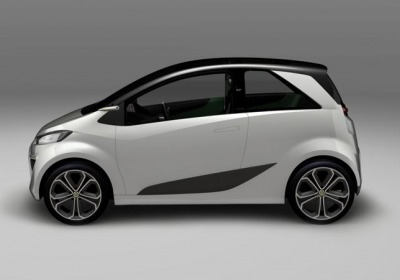Lotus City Car supermini: a future with Proton
Mon, 11 Oct 2010Lotus hopes to launch its city car with partner firm Proton, according to a new interview published today. The Lotus City Car concept was the sixth member of the Lotus Everything launchpad at this month's Paris motor show, and had been assumed to be a technical showcase rather than a serious production car.
However, in an interview with Automotive World, Lotus CEO Dany Bahar admits that the Lotus City Car was developed in tandem with its Malaysian owners Proton. Although a business case has yet to be settled, the will is clearly there to launch a Lotus supermini, as well as the five new sports cars unveiled in Paris.
Super-superminis are all the rage. Aston Martin yesterday unveiled the production version of the Cygnet mini, Maranello has fettled the Fiat 500 to produce the Abarth 695 Tributo Ferrari and now Lotus wants in on the small car scene.
The Lotus City Car is an crisply designed supermini with a fresh profile and rear-wheel drive. It is based on a new platform co-developed with Proton and the show car uses Lotus's hybrid powertrain: it shares the series hybrid system that underpins the Jaguar XJ Limo Green project. Although Lotus has a powertrain deal with Toyota, the hybrid project is in fact Lotus's own proprietary technology.
With a range-extending hybrid, the Lotus City Car can drive 25 miles on electric only charge; before the battery runs flat, a small 1.2-litre three-cylinder petrol engine starts up to charge it up - making the maximum range on one fill-up 310 miles.
Automotive World today published an interview with group managing director of Proton Holdings Berhad, Dato' Haji Syed Zainal Abidin Syed Mohamed Tahir, and the chief executive of Group Lotus, Dany Bahar. In it they reveal that the Lotus City Car has been co-developed by the two companies.
'The City Car concept is a perfect, real-life example of how the two companies - Lotus and Proton - can work together on an operational basis,' said Bahar. 'It is a car that we would like to share with Proton, and Proton would like to share with Lotus.
'There will be different positioning - they are different companies with different requirements - but it uses the same basic elements, and it uses for the first time a common approach to engineering and project management. It is not only that we are helping Proton out with services, but for the first time we are developing a car that suits Proton's needs, and suits our needs.'
Bahar goes on to hint that the Lotus City Car could in fact be the first hybridised vehicle to emerge from Hethel. It had been thought the sports cars would be the first part-electric vehicles, arriving from 2013.
How would a Lotus vary from the Proton? 'The [city] car is the car, whether it comes with two doors or four doors,' Bahar told Automotive World. 'There definitely will be differentiation, because the price positioning for Proton is obviously different, and their market focus is a little different as well. What the differentiation is we do not know yet.
'From our side, the introduction of a Lotus City Car is something very appealing, because there is a market for so-called sporty city cars, especially with the advancement of hybrid technology and electric vehicles. I think for us this could be the first exercise in bringing pure hybrid and pure electric vehicles to market, whilst remaining true to the sportiness that the Lotus brand offers to our clients.'
With Lotus planning to treble production, it seems certain that Hethel will not be able to cope with all manufacturing. In a second bombshell, Bahar admitted that production abroad was highly likely.
'The plant has an annual capacity of 10,000 units,' said Bahar. 'However, with the new requirements of the new models, obviously we have to invest in new machinery and expand lines, for example. We are also evaluating contract manufacturing options in Asia and in Europe. We are very open. We cannot say all cars will be produced in the UK, or one car will be built here and one there. Every car manufacturer is looking at where it can maximise efficiencies, and where it can reduce costs.'
It seems this incredible Norfolk tale is destined to run, and run.
Layout 3-door, 4-seater, rear-wheel drive
Drivetrain Series hybrid drivetrain
Range extender engine 35 kW, 1.2 litre, 3 cylinder engine
Engine fuel Flex-fuel (methanol, ethanol and petrol)
Battery Capacity 14.8 kWh
Power/Torque 162 kW peak (54 kW continuous)/ 240 Nm
0-50 km/h 4.5 seconds
0-100 km/h 9.0 seconds
Top speed 170 km/h
Range 500 km
EV range 60 km
CO2 emissions 60 g/km on the ECE-R101 cycle
Weight Less than 1,400 kg
Transmission Single speed transmission
By Tim Pollard

